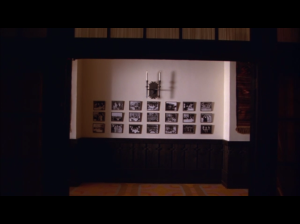The endings of Kubrick movies are arguably as enigmatic as the man himself, and The Shining - a 1980 adaptation of Stephen King’s supernatural horror novel – does nothing to buck that trend. After 90 mins of watching a father gradually exit reality stage-left, and witnessing his son form a supernatural/psychic bond with an old black man, we are left with a final shot that asks more questions than it answers.
SPOILERS.
Subsequent to Jack’s frosty death and the family’s escape, we see a slow tracking shot down one of the labyrinthian corridors of the hotel. At the end of the corridor is a collection of frames hanging on a wall, framed by a doorway; there is dark area inside the doorway leading into the light of the corridor. The pacing, framing and uncanny score over this scene causes a draw of focus and a blossoming of intrigue for the audience.
The pace of the tracking shot is so lingering it’s easy to find yourself urging on the camera to reveal what are the details of the pictures on the wall. As the main photo becomes visible in the shot, we see it shows Jack at the front of a crowd of Great Gatsby-esque, pre-Depression Americans in the throes of a celebration. A painfully slow pan down the photo reveals it was taken on the Independence Day celebrations of 1921. This film is set in 197-late, so we are all left wondering how did Jack appear in a photo 50 years prior? The greatest thing about this ending is that it is completely open to interpretation. My personal reading of the film is Jack gets literally consumed by the malevolent forces in the house, and his son’s psychic ability allows him to combat this evil and indirectly use it against his dad.
Danny has the ability to see into the past, which we see manifesting itself as the dead twins, and while being terrified at first, he seems unaffected. I believe it’s safe to assume these aren’t the only visions he has seen in his stay in the hotel. If Danny can see the hotel’s past, then he can see how the hotel manipulates its guests into committing brutal acts, can see his dad getting affected in real time, therefore stays one step ahead. The fact he retraces his steps in the maze could be a reference to retracing the history of the hotel to stay alive.
If Danny fights the hotel and stays alive, then Jack commits himself to the hotel by trying to engage sexually with a spectre. By doing so he gives himself up to the hotel, and gives himself up to the past. Some other manifestations of the past are the butler, a barman, the hotel guests, the aforementioned twins and that sexy spectre (who gets rapidly unsexy by decaying while Jack is trying it on with her). This supernatural element of the film gives weight to the assumption that Jack appearing in the photo is the hotel literally consuming him; when Jack is trapped in the food store, the hotel unlocks the door, which is weighty evidence of the hotel being more than just a building.

The Shining asks many more questions of its audience. Kubrick took a lot of criticism for changing many aspects of the book, but there is no denying the genius of the man, and this is potentially his most accessible work. If you haven’t seen the movie then you are silly for reading beyond our spoiler warning, but if you watch it you’ll enjoy it nonetheless.

